Economic Analysis of Solar Photovoltaic Systems: EGH404 Report
VerifiedAdded on 2022/11/10
|16
|3698
|163
Report
AI Summary
This report, prepared for the Research in Engineering Practice 2 course (EGH404), presents an economic analysis of rooftop solar photovoltaic (PV) systems, focusing on their potential to meet future energy demands. The study investigates various aspects of solar PV technology, including different battery technologies (lead-acid, lithium-ion), factors affecting PV module performance (irradiance, temperature, shading), and the feasibility of grid-connected systems. The analysis explores the impact of different tariffs on the economic benefits of battery systems and discusses software used in designing PV solar systems. The report also examines the pros and cons of PV battery systems, identifies gaps in assessing residential PV battery systems, and explores the role of government in solar system installation. The overall aim is to provide accurate and reliable information to governments, policymakers, investors, and utilities, enabling them to make informed decisions regarding renewable energy technologies. The report also includes an analysis of the advantages and disadvantages of solar PV systems, addressing their cost-effectiveness, convenience, and applicability in various regions, as well as their role in promoting energy dependence and minimizing carbon footprint.

RESEARCH IN ENGINEERING PRACTICE 1
Research in Engineering Practice
Course
Date
Research in Engineering Practice
Course
Date
Paraphrase This Document
Need a fresh take? Get an instant paraphrase of this document with our AI Paraphraser
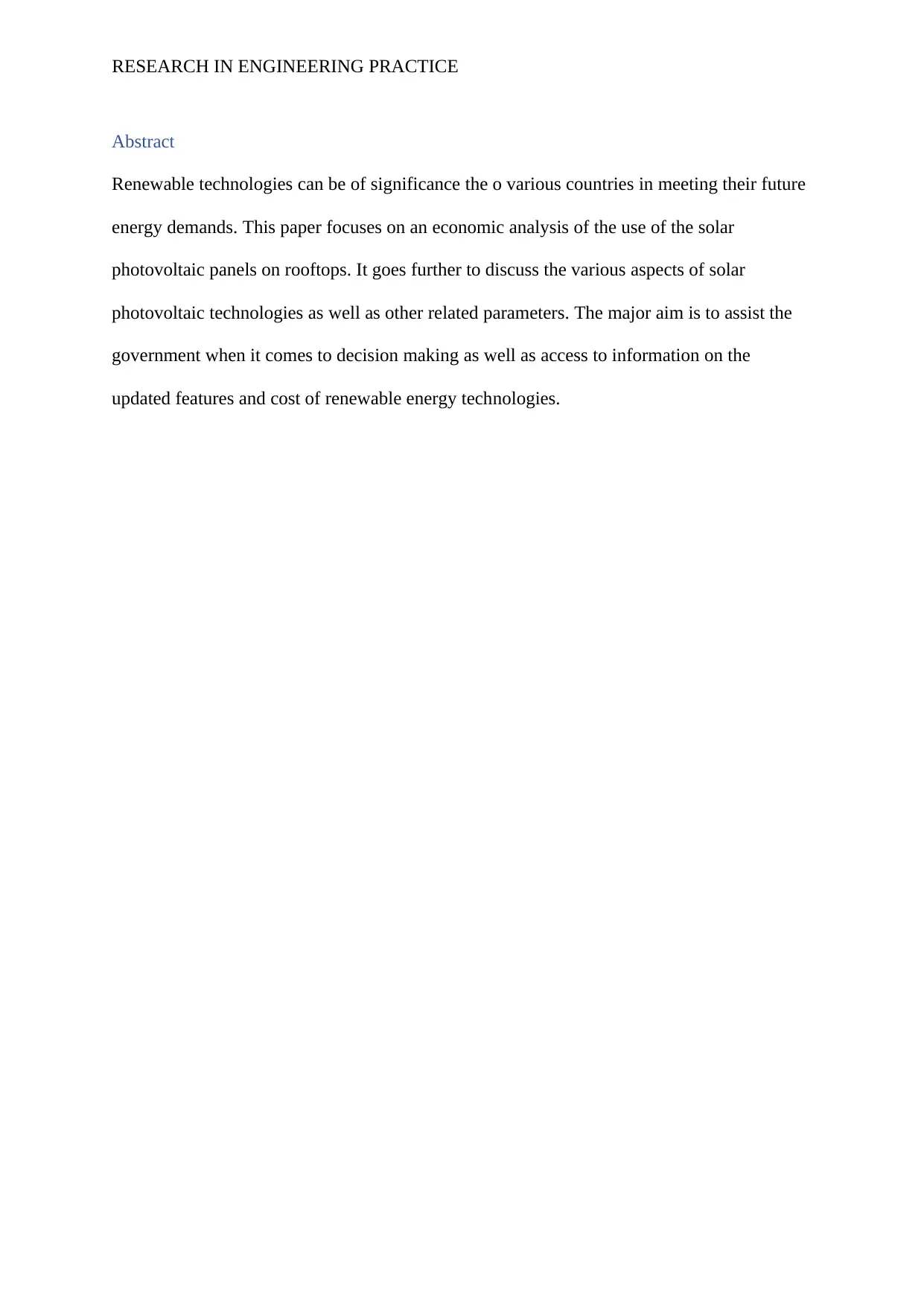
RESEARCH IN ENGINEERING PRACTICE
Abstract
Renewable technologies can be of significance the o various countries in meeting their future
energy demands. This paper focuses on an economic analysis of the use of the solar
photovoltaic panels on rooftops. It goes further to discuss the various aspects of solar
photovoltaic technologies as well as other related parameters. The major aim is to assist the
government when it comes to decision making as well as access to information on the
updated features and cost of renewable energy technologies.
Abstract
Renewable technologies can be of significance the o various countries in meeting their future
energy demands. This paper focuses on an economic analysis of the use of the solar
photovoltaic panels on rooftops. It goes further to discuss the various aspects of solar
photovoltaic technologies as well as other related parameters. The major aim is to assist the
government when it comes to decision making as well as access to information on the
updated features and cost of renewable energy technologies.
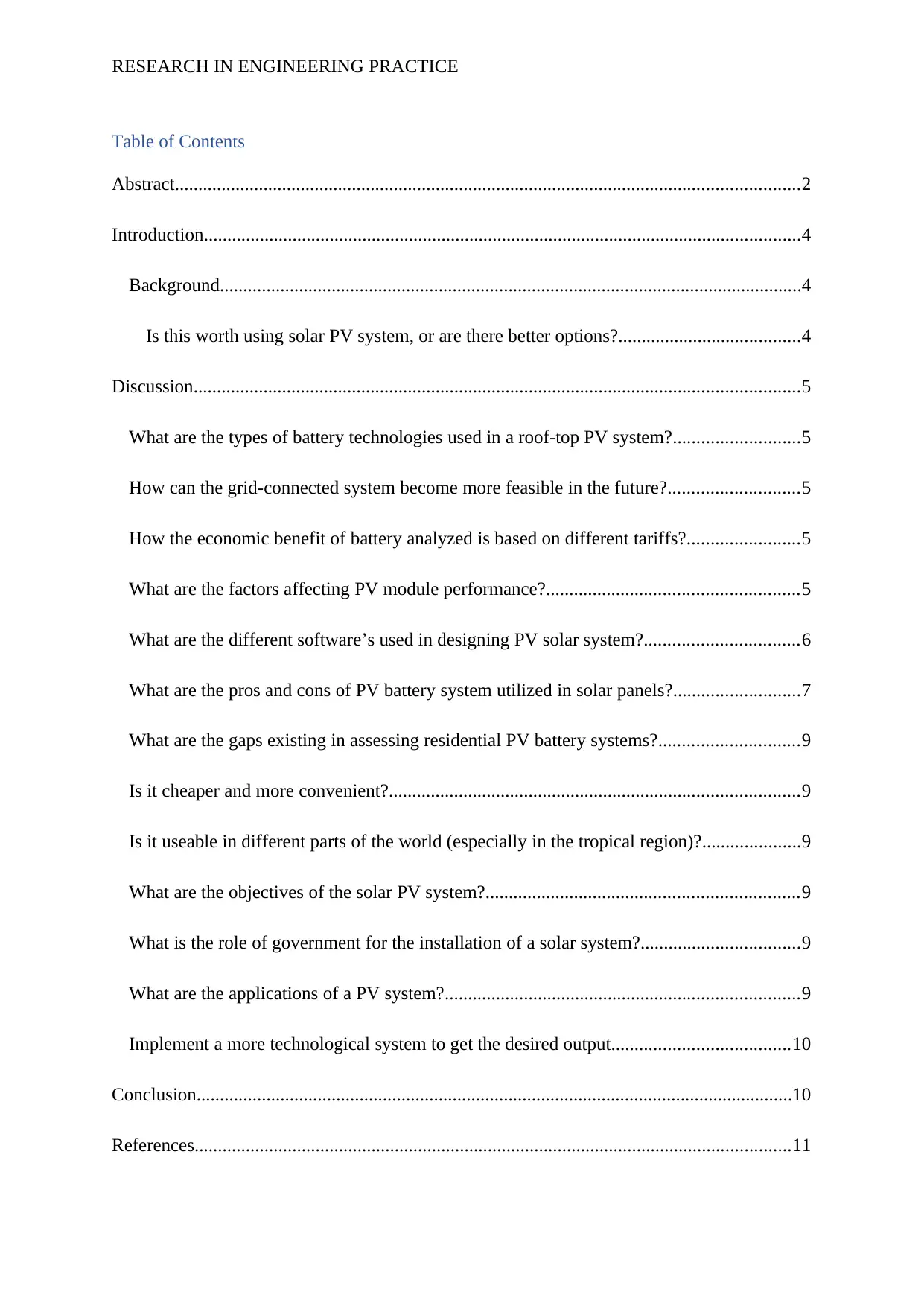
RESEARCH IN ENGINEERING PRACTICE
Table of Contents
Abstract......................................................................................................................................2
Introduction................................................................................................................................4
Background.............................................................................................................................4
Is this worth using solar PV system, or are there better options?.......................................4
Discussion..................................................................................................................................5
What are the types of battery technologies used in a roof-top PV system?...........................5
How can the grid-connected system become more feasible in the future?............................5
How the economic benefit of battery analyzed is based on different tariffs?........................5
What are the factors affecting PV module performance?......................................................5
What are the different software’s used in designing PV solar system?.................................6
What are the pros and cons of PV battery system utilized in solar panels?...........................7
What are the gaps existing in assessing residential PV battery systems?..............................9
Is it cheaper and more convenient?........................................................................................9
Is it useable in different parts of the world (especially in the tropical region)?.....................9
What are the objectives of the solar PV system?...................................................................9
What is the role of government for the installation of a solar system?..................................9
What are the applications of a PV system?............................................................................9
Implement a more technological system to get the desired output......................................10
Conclusion................................................................................................................................10
References................................................................................................................................11
Table of Contents
Abstract......................................................................................................................................2
Introduction................................................................................................................................4
Background.............................................................................................................................4
Is this worth using solar PV system, or are there better options?.......................................4
Discussion..................................................................................................................................5
What are the types of battery technologies used in a roof-top PV system?...........................5
How can the grid-connected system become more feasible in the future?............................5
How the economic benefit of battery analyzed is based on different tariffs?........................5
What are the factors affecting PV module performance?......................................................5
What are the different software’s used in designing PV solar system?.................................6
What are the pros and cons of PV battery system utilized in solar panels?...........................7
What are the gaps existing in assessing residential PV battery systems?..............................9
Is it cheaper and more convenient?........................................................................................9
Is it useable in different parts of the world (especially in the tropical region)?.....................9
What are the objectives of the solar PV system?...................................................................9
What is the role of government for the installation of a solar system?..................................9
What are the applications of a PV system?............................................................................9
Implement a more technological system to get the desired output......................................10
Conclusion................................................................................................................................10
References................................................................................................................................11
⊘ This is a preview!⊘
Do you want full access?
Subscribe today to unlock all pages.

Trusted by 1+ million students worldwide
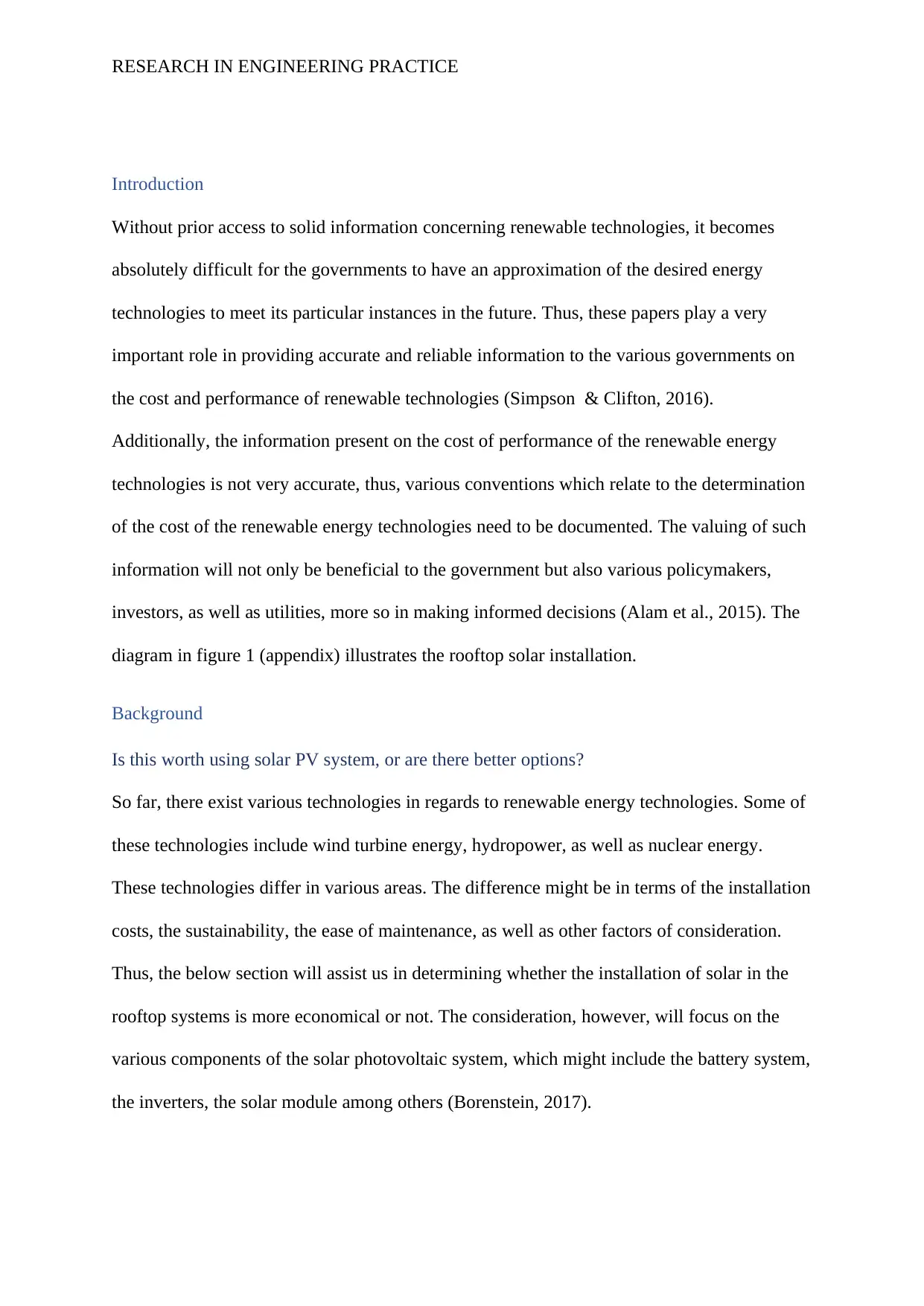
RESEARCH IN ENGINEERING PRACTICE
Introduction
Without prior access to solid information concerning renewable technologies, it becomes
absolutely difficult for the governments to have an approximation of the desired energy
technologies to meet its particular instances in the future. Thus, these papers play a very
important role in providing accurate and reliable information to the various governments on
the cost and performance of renewable technologies (Simpson & Clifton, 2016).
Additionally, the information present on the cost of performance of the renewable energy
technologies is not very accurate, thus, various conventions which relate to the determination
of the cost of the renewable energy technologies need to be documented. The valuing of such
information will not only be beneficial to the government but also various policymakers,
investors, as well as utilities, more so in making informed decisions (Alam et al., 2015). The
diagram in figure 1 (appendix) illustrates the rooftop solar installation.
Background
Is this worth using solar PV system, or are there better options?
So far, there exist various technologies in regards to renewable energy technologies. Some of
these technologies include wind turbine energy, hydropower, as well as nuclear energy.
These technologies differ in various areas. The difference might be in terms of the installation
costs, the sustainability, the ease of maintenance, as well as other factors of consideration.
Thus, the below section will assist us in determining whether the installation of solar in the
rooftop systems is more economical or not. The consideration, however, will focus on the
various components of the solar photovoltaic system, which might include the battery system,
the inverters, the solar module among others (Borenstein, 2017).
Introduction
Without prior access to solid information concerning renewable technologies, it becomes
absolutely difficult for the governments to have an approximation of the desired energy
technologies to meet its particular instances in the future. Thus, these papers play a very
important role in providing accurate and reliable information to the various governments on
the cost and performance of renewable technologies (Simpson & Clifton, 2016).
Additionally, the information present on the cost of performance of the renewable energy
technologies is not very accurate, thus, various conventions which relate to the determination
of the cost of the renewable energy technologies need to be documented. The valuing of such
information will not only be beneficial to the government but also various policymakers,
investors, as well as utilities, more so in making informed decisions (Alam et al., 2015). The
diagram in figure 1 (appendix) illustrates the rooftop solar installation.
Background
Is this worth using solar PV system, or are there better options?
So far, there exist various technologies in regards to renewable energy technologies. Some of
these technologies include wind turbine energy, hydropower, as well as nuclear energy.
These technologies differ in various areas. The difference might be in terms of the installation
costs, the sustainability, the ease of maintenance, as well as other factors of consideration.
Thus, the below section will assist us in determining whether the installation of solar in the
rooftop systems is more economical or not. The consideration, however, will focus on the
various components of the solar photovoltaic system, which might include the battery system,
the inverters, the solar module among others (Borenstein, 2017).
Paraphrase This Document
Need a fresh take? Get an instant paraphrase of this document with our AI Paraphraser
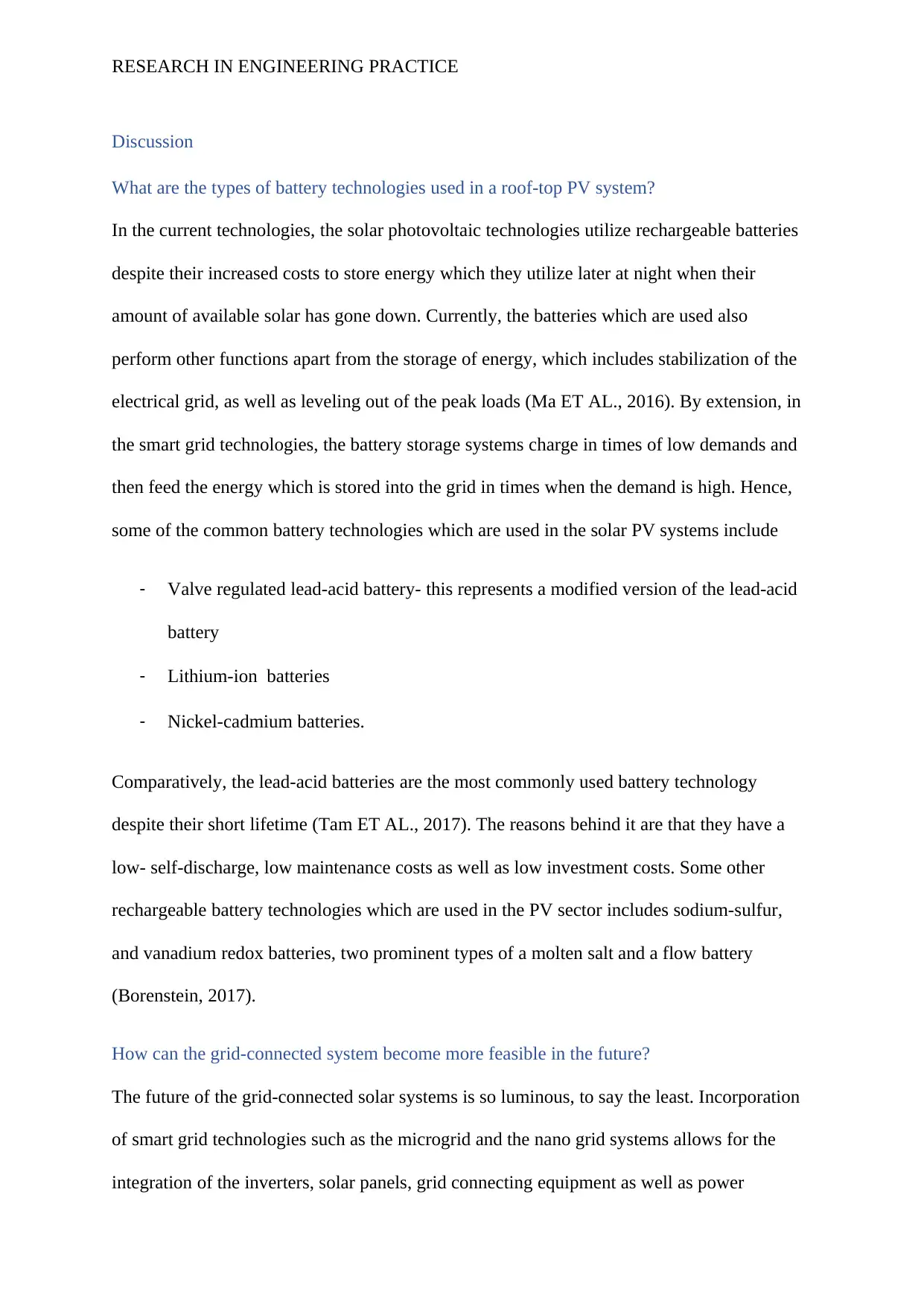
RESEARCH IN ENGINEERING PRACTICE
Discussion
What are the types of battery technologies used in a roof-top PV system?
In the current technologies, the solar photovoltaic technologies utilize rechargeable batteries
despite their increased costs to store energy which they utilize later at night when their
amount of available solar has gone down. Currently, the batteries which are used also
perform other functions apart from the storage of energy, which includes stabilization of the
electrical grid, as well as leveling out of the peak loads (Ma ET AL., 2016). By extension, in
the smart grid technologies, the battery storage systems charge in times of low demands and
then feed the energy which is stored into the grid in times when the demand is high. Hence,
some of the common battery technologies which are used in the solar PV systems include
- Valve regulated lead-acid battery- this represents a modified version of the lead-acid
battery
- Lithium-ion batteries
- Nickel-cadmium batteries.
Comparatively, the lead-acid batteries are the most commonly used battery technology
despite their short lifetime (Tam ET AL., 2017). The reasons behind it are that they have a
low- self-discharge, low maintenance costs as well as low investment costs. Some other
rechargeable battery technologies which are used in the PV sector includes sodium-sulfur,
and vanadium redox batteries, two prominent types of a molten salt and a flow battery
(Borenstein, 2017).
How can the grid-connected system become more feasible in the future?
The future of the grid-connected solar systems is so luminous, to say the least. Incorporation
of smart grid technologies such as the microgrid and the nano grid systems allows for the
integration of the inverters, solar panels, grid connecting equipment as well as power
Discussion
What are the types of battery technologies used in a roof-top PV system?
In the current technologies, the solar photovoltaic technologies utilize rechargeable batteries
despite their increased costs to store energy which they utilize later at night when their
amount of available solar has gone down. Currently, the batteries which are used also
perform other functions apart from the storage of energy, which includes stabilization of the
electrical grid, as well as leveling out of the peak loads (Ma ET AL., 2016). By extension, in
the smart grid technologies, the battery storage systems charge in times of low demands and
then feed the energy which is stored into the grid in times when the demand is high. Hence,
some of the common battery technologies which are used in the solar PV systems include
- Valve regulated lead-acid battery- this represents a modified version of the lead-acid
battery
- Lithium-ion batteries
- Nickel-cadmium batteries.
Comparatively, the lead-acid batteries are the most commonly used battery technology
despite their short lifetime (Tam ET AL., 2017). The reasons behind it are that they have a
low- self-discharge, low maintenance costs as well as low investment costs. Some other
rechargeable battery technologies which are used in the PV sector includes sodium-sulfur,
and vanadium redox batteries, two prominent types of a molten salt and a flow battery
(Borenstein, 2017).
How can the grid-connected system become more feasible in the future?
The future of the grid-connected solar systems is so luminous, to say the least. Incorporation
of smart grid technologies such as the microgrid and the nano grid systems allows for the
integration of the inverters, solar panels, grid connecting equipment as well as power
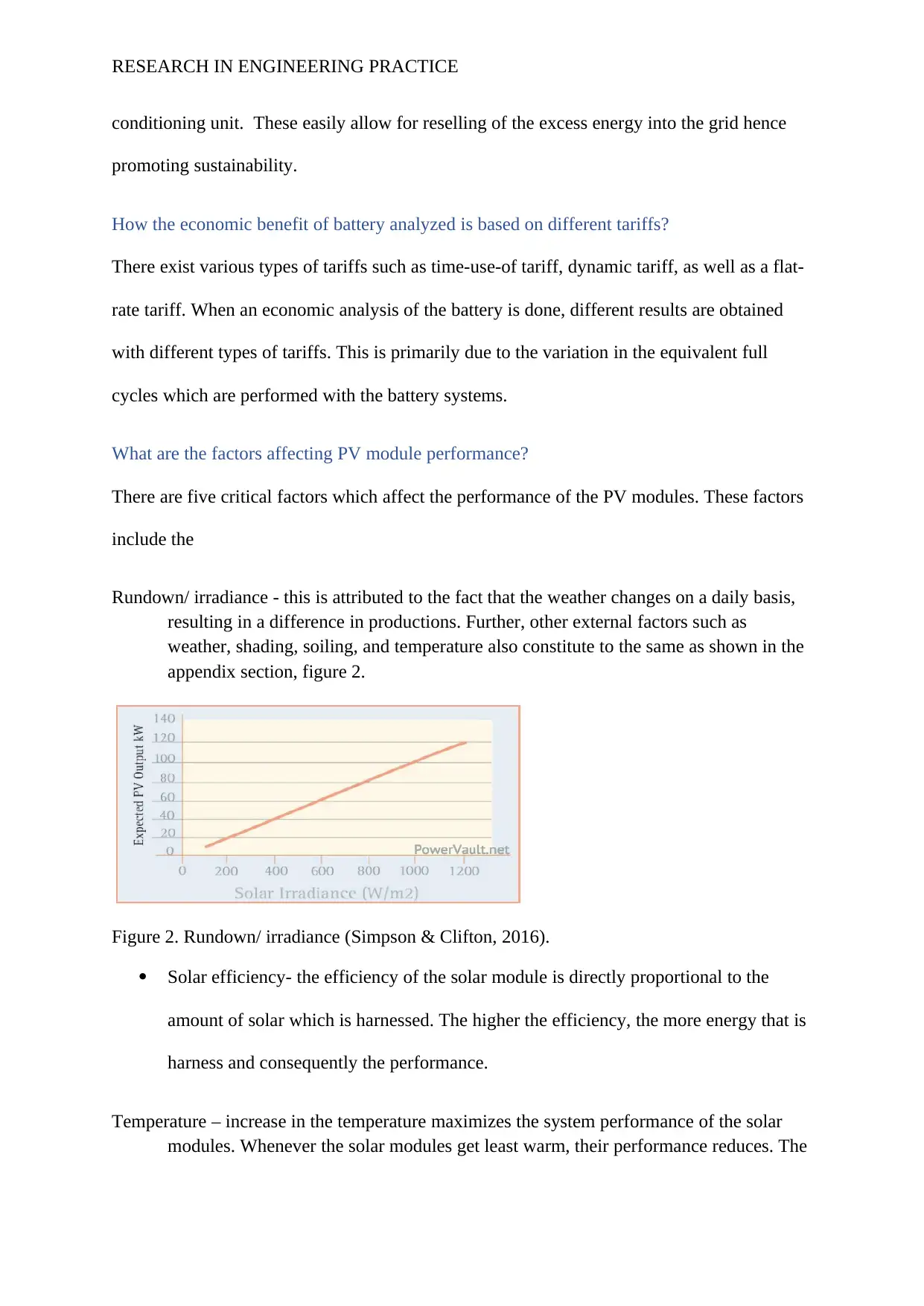
RESEARCH IN ENGINEERING PRACTICE
conditioning unit. These easily allow for reselling of the excess energy into the grid hence
promoting sustainability.
How the economic benefit of battery analyzed is based on different tariffs?
There exist various types of tariffs such as time-use-of tariff, dynamic tariff, as well as a flat-
rate tariff. When an economic analysis of the battery is done, different results are obtained
with different types of tariffs. This is primarily due to the variation in the equivalent full
cycles which are performed with the battery systems.
What are the factors affecting PV module performance?
There are five critical factors which affect the performance of the PV modules. These factors
include the
Rundown/ irradiance - this is attributed to the fact that the weather changes on a daily basis,
resulting in a difference in productions. Further, other external factors such as
weather, shading, soiling, and temperature also constitute to the same as shown in the
appendix section, figure 2.
Figure 2. Rundown/ irradiance (Simpson & Clifton, 2016).
Solar efficiency- the efficiency of the solar module is directly proportional to the
amount of solar which is harnessed. The higher the efficiency, the more energy that is
harness and consequently the performance.
Temperature – increase in the temperature maximizes the system performance of the solar
modules. Whenever the solar modules get least warm, their performance reduces. The
conditioning unit. These easily allow for reselling of the excess energy into the grid hence
promoting sustainability.
How the economic benefit of battery analyzed is based on different tariffs?
There exist various types of tariffs such as time-use-of tariff, dynamic tariff, as well as a flat-
rate tariff. When an economic analysis of the battery is done, different results are obtained
with different types of tariffs. This is primarily due to the variation in the equivalent full
cycles which are performed with the battery systems.
What are the factors affecting PV module performance?
There are five critical factors which affect the performance of the PV modules. These factors
include the
Rundown/ irradiance - this is attributed to the fact that the weather changes on a daily basis,
resulting in a difference in productions. Further, other external factors such as
weather, shading, soiling, and temperature also constitute to the same as shown in the
appendix section, figure 2.
Figure 2. Rundown/ irradiance (Simpson & Clifton, 2016).
Solar efficiency- the efficiency of the solar module is directly proportional to the
amount of solar which is harnessed. The higher the efficiency, the more energy that is
harness and consequently the performance.
Temperature – increase in the temperature maximizes the system performance of the solar
modules. Whenever the solar modules get least warm, their performance reduces. The
⊘ This is a preview!⊘
Do you want full access?
Subscribe today to unlock all pages.

Trusted by 1+ million students worldwide
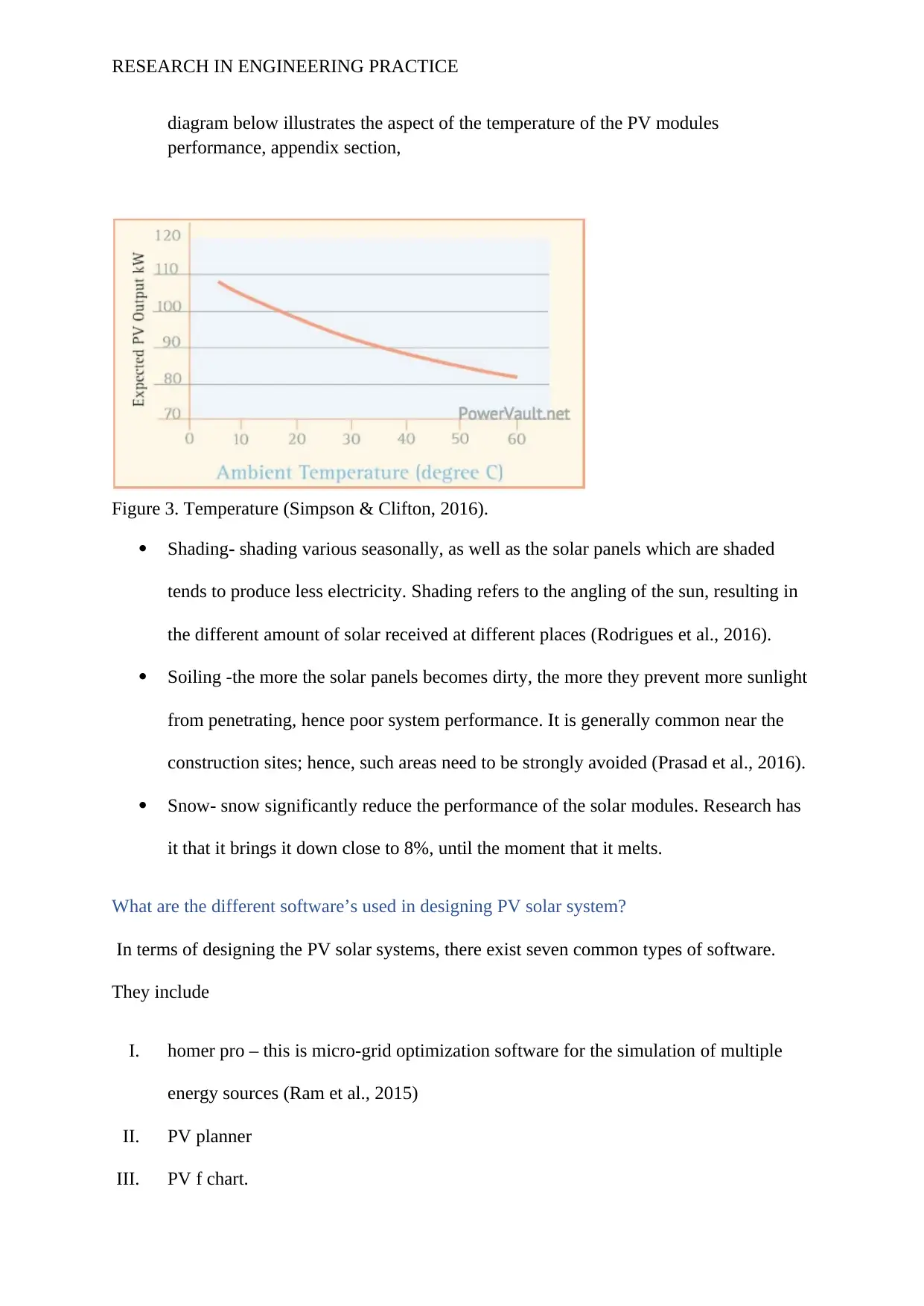
RESEARCH IN ENGINEERING PRACTICE
diagram below illustrates the aspect of the temperature of the PV modules
performance, appendix section,
Figure 3. Temperature (Simpson & Clifton, 2016).
Shading- shading various seasonally, as well as the solar panels which are shaded
tends to produce less electricity. Shading refers to the angling of the sun, resulting in
the different amount of solar received at different places (Rodrigues et al., 2016).
Soiling -the more the solar panels becomes dirty, the more they prevent more sunlight
from penetrating, hence poor system performance. It is generally common near the
construction sites; hence, such areas need to be strongly avoided (Prasad et al., 2016).
Snow- snow significantly reduce the performance of the solar modules. Research has
it that it brings it down close to 8%, until the moment that it melts.
What are the different software’s used in designing PV solar system?
In terms of designing the PV solar systems, there exist seven common types of software.
They include
I. homer pro – this is micro-grid optimization software for the simulation of multiple
energy sources (Ram et al., 2015)
II. PV planner
III. PV f chart.
diagram below illustrates the aspect of the temperature of the PV modules
performance, appendix section,
Figure 3. Temperature (Simpson & Clifton, 2016).
Shading- shading various seasonally, as well as the solar panels which are shaded
tends to produce less electricity. Shading refers to the angling of the sun, resulting in
the different amount of solar received at different places (Rodrigues et al., 2016).
Soiling -the more the solar panels becomes dirty, the more they prevent more sunlight
from penetrating, hence poor system performance. It is generally common near the
construction sites; hence, such areas need to be strongly avoided (Prasad et al., 2016).
Snow- snow significantly reduce the performance of the solar modules. Research has
it that it brings it down close to 8%, until the moment that it melts.
What are the different software’s used in designing PV solar system?
In terms of designing the PV solar systems, there exist seven common types of software.
They include
I. homer pro – this is micro-grid optimization software for the simulation of multiple
energy sources (Ram et al., 2015)
II. PV planner
III. PV f chart.
Paraphrase This Document
Need a fresh take? Get an instant paraphrase of this document with our AI Paraphraser
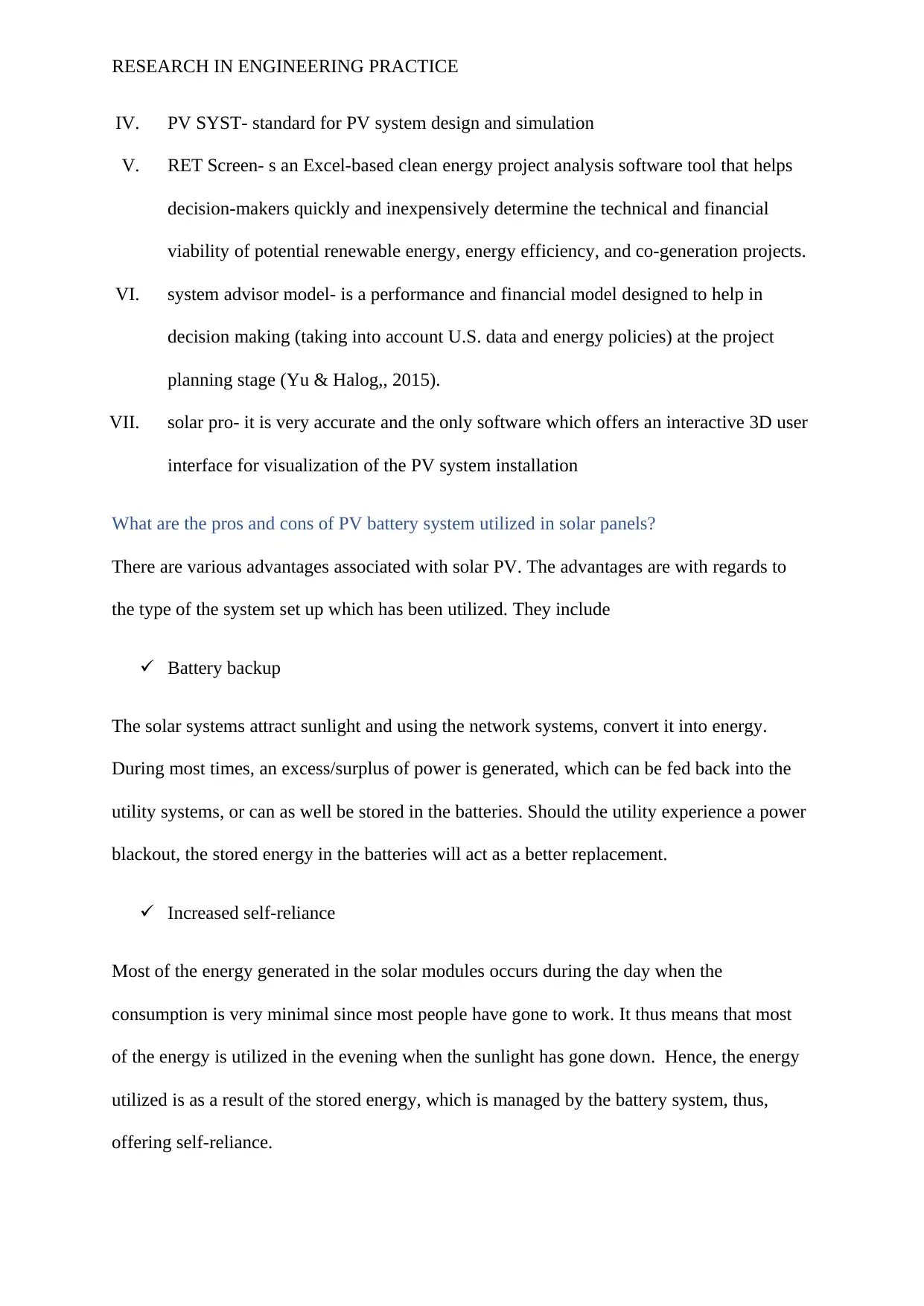
RESEARCH IN ENGINEERING PRACTICE
IV. PV SYST- standard for PV system design and simulation
V. RET Screen- s an Excel-based clean energy project analysis software tool that helps
decision-makers quickly and inexpensively determine the technical and financial
viability of potential renewable energy, energy efficiency, and co-generation projects.
VI. system advisor model- is a performance and financial model designed to help in
decision making (taking into account U.S. data and energy policies) at the project
planning stage (Yu & Halog,, 2015).
VII. solar pro- it is very accurate and the only software which offers an interactive 3D user
interface for visualization of the PV system installation
What are the pros and cons of PV battery system utilized in solar panels?
There are various advantages associated with solar PV. The advantages are with regards to
the type of the system set up which has been utilized. They include
Battery backup
The solar systems attract sunlight and using the network systems, convert it into energy.
During most times, an excess/surplus of power is generated, which can be fed back into the
utility systems, or can as well be stored in the batteries. Should the utility experience a power
blackout, the stored energy in the batteries will act as a better replacement.
Increased self-reliance
Most of the energy generated in the solar modules occurs during the day when the
consumption is very minimal since most people have gone to work. It thus means that most
of the energy is utilized in the evening when the sunlight has gone down. Hence, the energy
utilized is as a result of the stored energy, which is managed by the battery system, thus,
offering self-reliance.
IV. PV SYST- standard for PV system design and simulation
V. RET Screen- s an Excel-based clean energy project analysis software tool that helps
decision-makers quickly and inexpensively determine the technical and financial
viability of potential renewable energy, energy efficiency, and co-generation projects.
VI. system advisor model- is a performance and financial model designed to help in
decision making (taking into account U.S. data and energy policies) at the project
planning stage (Yu & Halog,, 2015).
VII. solar pro- it is very accurate and the only software which offers an interactive 3D user
interface for visualization of the PV system installation
What are the pros and cons of PV battery system utilized in solar panels?
There are various advantages associated with solar PV. The advantages are with regards to
the type of the system set up which has been utilized. They include
Battery backup
The solar systems attract sunlight and using the network systems, convert it into energy.
During most times, an excess/surplus of power is generated, which can be fed back into the
utility systems, or can as well be stored in the batteries. Should the utility experience a power
blackout, the stored energy in the batteries will act as a better replacement.
Increased self-reliance
Most of the energy generated in the solar modules occurs during the day when the
consumption is very minimal since most people have gone to work. It thus means that most
of the energy is utilized in the evening when the sunlight has gone down. Hence, the energy
utilized is as a result of the stored energy, which is managed by the battery system, thus,
offering self-reliance.
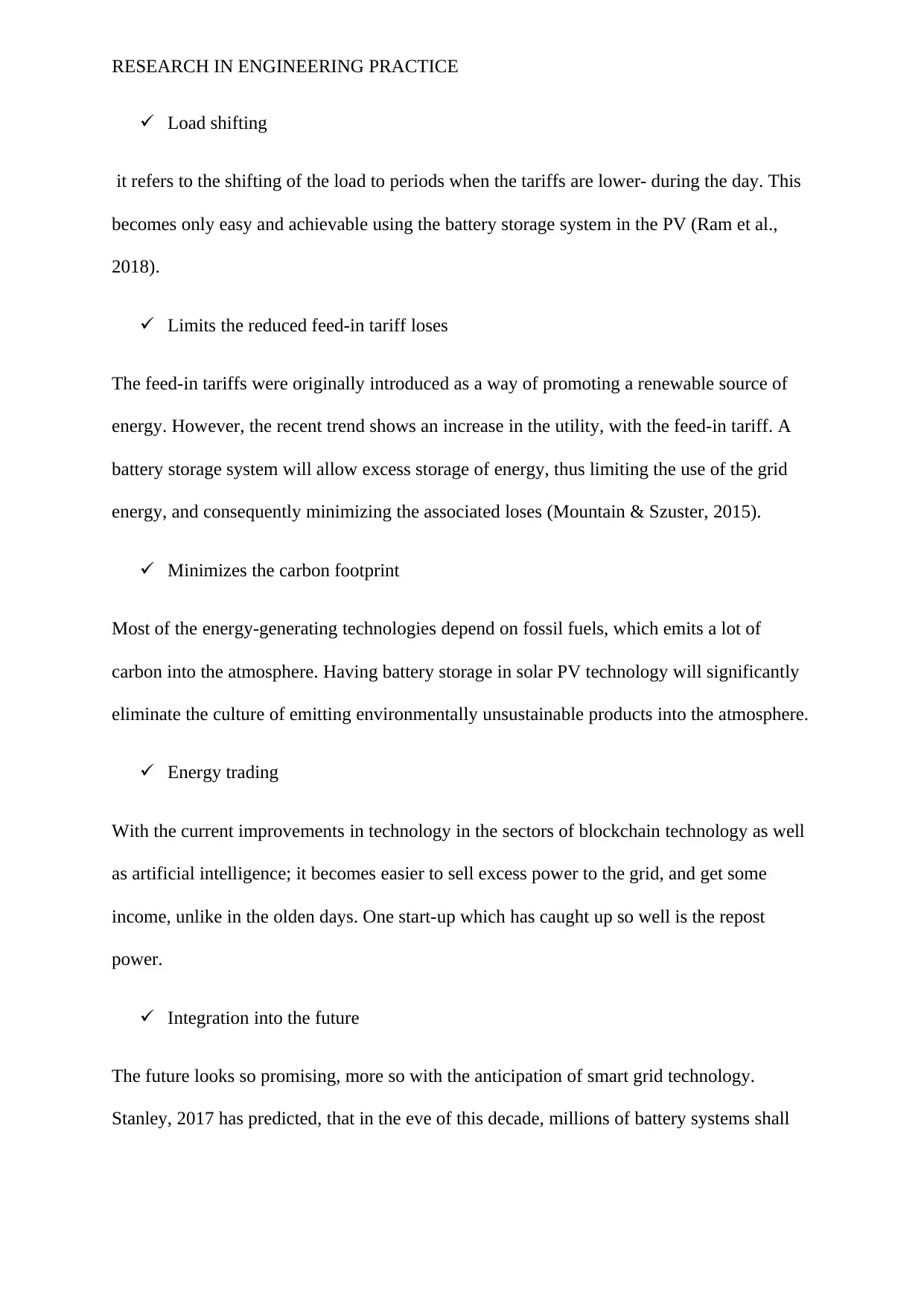
RESEARCH IN ENGINEERING PRACTICE
Load shifting
it refers to the shifting of the load to periods when the tariffs are lower- during the day. This
becomes only easy and achievable using the battery storage system in the PV (Ram et al.,
2018).
Limits the reduced feed-in tariff loses
The feed-in tariffs were originally introduced as a way of promoting a renewable source of
energy. However, the recent trend shows an increase in the utility, with the feed-in tariff. A
battery storage system will allow excess storage of energy, thus limiting the use of the grid
energy, and consequently minimizing the associated loses (Mountain & Szuster, 2015).
Minimizes the carbon footprint
Most of the energy-generating technologies depend on fossil fuels, which emits a lot of
carbon into the atmosphere. Having battery storage in solar PV technology will significantly
eliminate the culture of emitting environmentally unsustainable products into the atmosphere.
Energy trading
With the current improvements in technology in the sectors of blockchain technology as well
as artificial intelligence; it becomes easier to sell excess power to the grid, and get some
income, unlike in the olden days. One start-up which has caught up so well is the repost
power.
Integration into the future
The future looks so promising, more so with the anticipation of smart grid technology.
Stanley, 2017 has predicted, that in the eve of this decade, millions of battery systems shall
Load shifting
it refers to the shifting of the load to periods when the tariffs are lower- during the day. This
becomes only easy and achievable using the battery storage system in the PV (Ram et al.,
2018).
Limits the reduced feed-in tariff loses
The feed-in tariffs were originally introduced as a way of promoting a renewable source of
energy. However, the recent trend shows an increase in the utility, with the feed-in tariff. A
battery storage system will allow excess storage of energy, thus limiting the use of the grid
energy, and consequently minimizing the associated loses (Mountain & Szuster, 2015).
Minimizes the carbon footprint
Most of the energy-generating technologies depend on fossil fuels, which emits a lot of
carbon into the atmosphere. Having battery storage in solar PV technology will significantly
eliminate the culture of emitting environmentally unsustainable products into the atmosphere.
Energy trading
With the current improvements in technology in the sectors of blockchain technology as well
as artificial intelligence; it becomes easier to sell excess power to the grid, and get some
income, unlike in the olden days. One start-up which has caught up so well is the repost
power.
Integration into the future
The future looks so promising, more so with the anticipation of smart grid technology.
Stanley, 2017 has predicted, that in the eve of this decade, millions of battery systems shall
⊘ This is a preview!⊘
Do you want full access?
Subscribe today to unlock all pages.

Trusted by 1+ million students worldwide
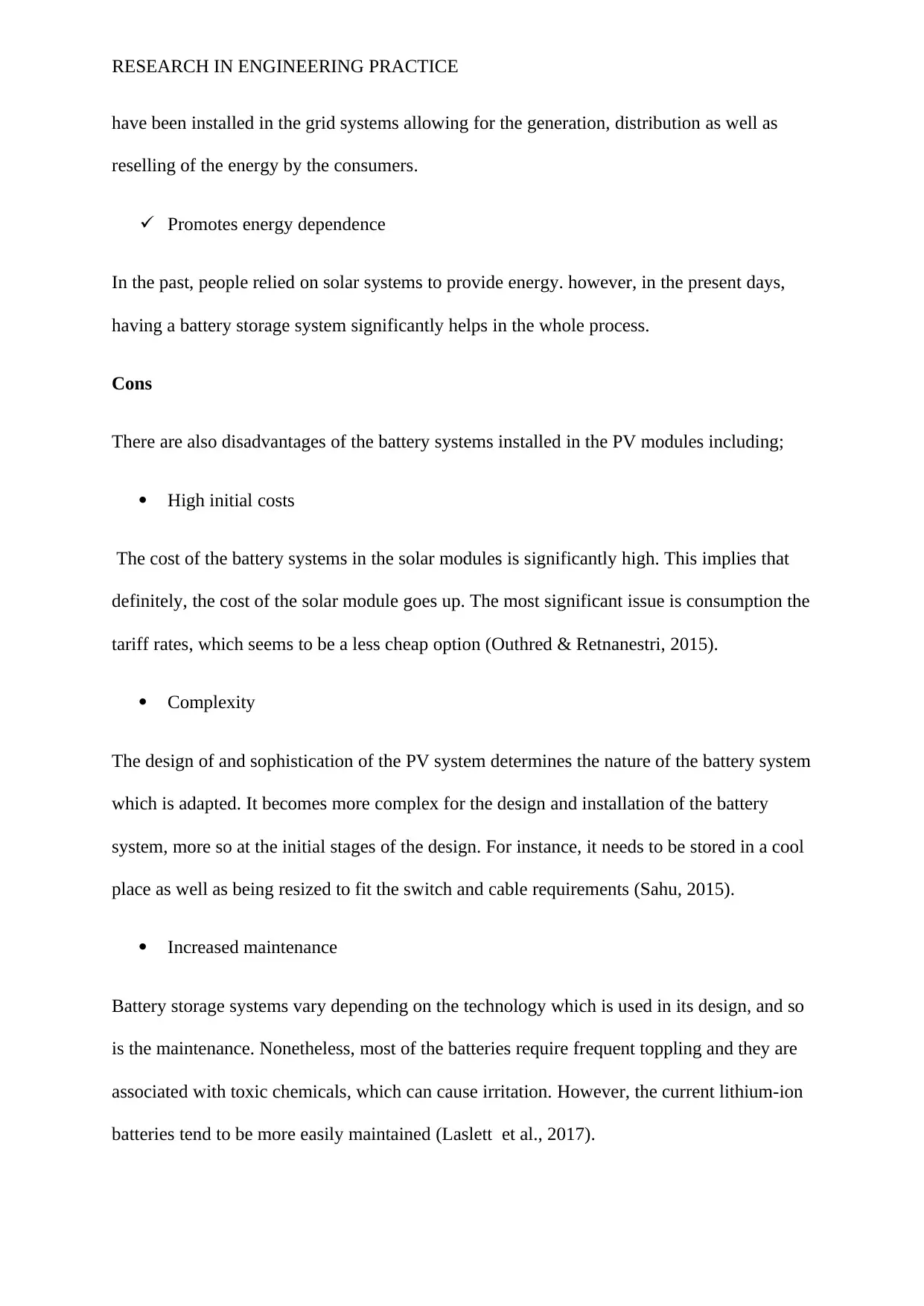
RESEARCH IN ENGINEERING PRACTICE
have been installed in the grid systems allowing for the generation, distribution as well as
reselling of the energy by the consumers.
Promotes energy dependence
In the past, people relied on solar systems to provide energy. however, in the present days,
having a battery storage system significantly helps in the whole process.
Cons
There are also disadvantages of the battery systems installed in the PV modules including;
High initial costs
The cost of the battery systems in the solar modules is significantly high. This implies that
definitely, the cost of the solar module goes up. The most significant issue is consumption the
tariff rates, which seems to be a less cheap option (Outhred & Retnanestri, 2015).
Complexity
The design of and sophistication of the PV system determines the nature of the battery system
which is adapted. It becomes more complex for the design and installation of the battery
system, more so at the initial stages of the design. For instance, it needs to be stored in a cool
place as well as being resized to fit the switch and cable requirements (Sahu, 2015).
Increased maintenance
Battery storage systems vary depending on the technology which is used in its design, and so
is the maintenance. Nonetheless, most of the batteries require frequent toppling and they are
associated with toxic chemicals, which can cause irritation. However, the current lithium-ion
batteries tend to be more easily maintained (Laslett et al., 2017).
have been installed in the grid systems allowing for the generation, distribution as well as
reselling of the energy by the consumers.
Promotes energy dependence
In the past, people relied on solar systems to provide energy. however, in the present days,
having a battery storage system significantly helps in the whole process.
Cons
There are also disadvantages of the battery systems installed in the PV modules including;
High initial costs
The cost of the battery systems in the solar modules is significantly high. This implies that
definitely, the cost of the solar module goes up. The most significant issue is consumption the
tariff rates, which seems to be a less cheap option (Outhred & Retnanestri, 2015).
Complexity
The design of and sophistication of the PV system determines the nature of the battery system
which is adapted. It becomes more complex for the design and installation of the battery
system, more so at the initial stages of the design. For instance, it needs to be stored in a cool
place as well as being resized to fit the switch and cable requirements (Sahu, 2015).
Increased maintenance
Battery storage systems vary depending on the technology which is used in its design, and so
is the maintenance. Nonetheless, most of the batteries require frequent toppling and they are
associated with toxic chemicals, which can cause irritation. However, the current lithium-ion
batteries tend to be more easily maintained (Laslett et al., 2017).
Paraphrase This Document
Need a fresh take? Get an instant paraphrase of this document with our AI Paraphraser
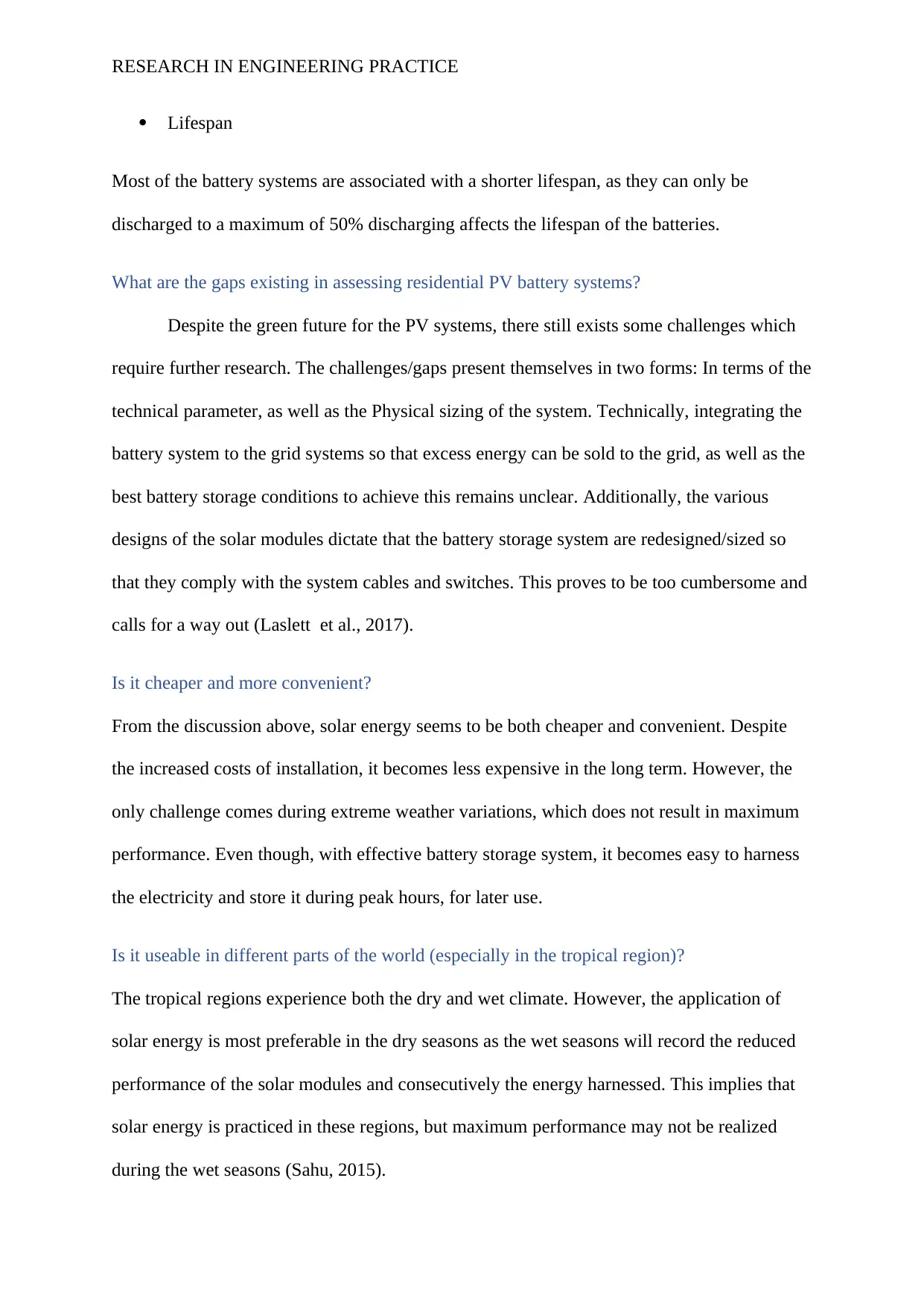
RESEARCH IN ENGINEERING PRACTICE
Lifespan
Most of the battery systems are associated with a shorter lifespan, as they can only be
discharged to a maximum of 50% discharging affects the lifespan of the batteries.
What are the gaps existing in assessing residential PV battery systems?
Despite the green future for the PV systems, there still exists some challenges which
require further research. The challenges/gaps present themselves in two forms: In terms of the
technical parameter, as well as the Physical sizing of the system. Technically, integrating the
battery system to the grid systems so that excess energy can be sold to the grid, as well as the
best battery storage conditions to achieve this remains unclear. Additionally, the various
designs of the solar modules dictate that the battery storage system are redesigned/sized so
that they comply with the system cables and switches. This proves to be too cumbersome and
calls for a way out (Laslett et al., 2017).
Is it cheaper and more convenient?
From the discussion above, solar energy seems to be both cheaper and convenient. Despite
the increased costs of installation, it becomes less expensive in the long term. However, the
only challenge comes during extreme weather variations, which does not result in maximum
performance. Even though, with effective battery storage system, it becomes easy to harness
the electricity and store it during peak hours, for later use.
Is it useable in different parts of the world (especially in the tropical region)?
The tropical regions experience both the dry and wet climate. However, the application of
solar energy is most preferable in the dry seasons as the wet seasons will record the reduced
performance of the solar modules and consecutively the energy harnessed. This implies that
solar energy is practiced in these regions, but maximum performance may not be realized
during the wet seasons (Sahu, 2015).
Lifespan
Most of the battery systems are associated with a shorter lifespan, as they can only be
discharged to a maximum of 50% discharging affects the lifespan of the batteries.
What are the gaps existing in assessing residential PV battery systems?
Despite the green future for the PV systems, there still exists some challenges which
require further research. The challenges/gaps present themselves in two forms: In terms of the
technical parameter, as well as the Physical sizing of the system. Technically, integrating the
battery system to the grid systems so that excess energy can be sold to the grid, as well as the
best battery storage conditions to achieve this remains unclear. Additionally, the various
designs of the solar modules dictate that the battery storage system are redesigned/sized so
that they comply with the system cables and switches. This proves to be too cumbersome and
calls for a way out (Laslett et al., 2017).
Is it cheaper and more convenient?
From the discussion above, solar energy seems to be both cheaper and convenient. Despite
the increased costs of installation, it becomes less expensive in the long term. However, the
only challenge comes during extreme weather variations, which does not result in maximum
performance. Even though, with effective battery storage system, it becomes easy to harness
the electricity and store it during peak hours, for later use.
Is it useable in different parts of the world (especially in the tropical region)?
The tropical regions experience both the dry and wet climate. However, the application of
solar energy is most preferable in the dry seasons as the wet seasons will record the reduced
performance of the solar modules and consecutively the energy harnessed. This implies that
solar energy is practiced in these regions, but maximum performance may not be realized
during the wet seasons (Sahu, 2015).
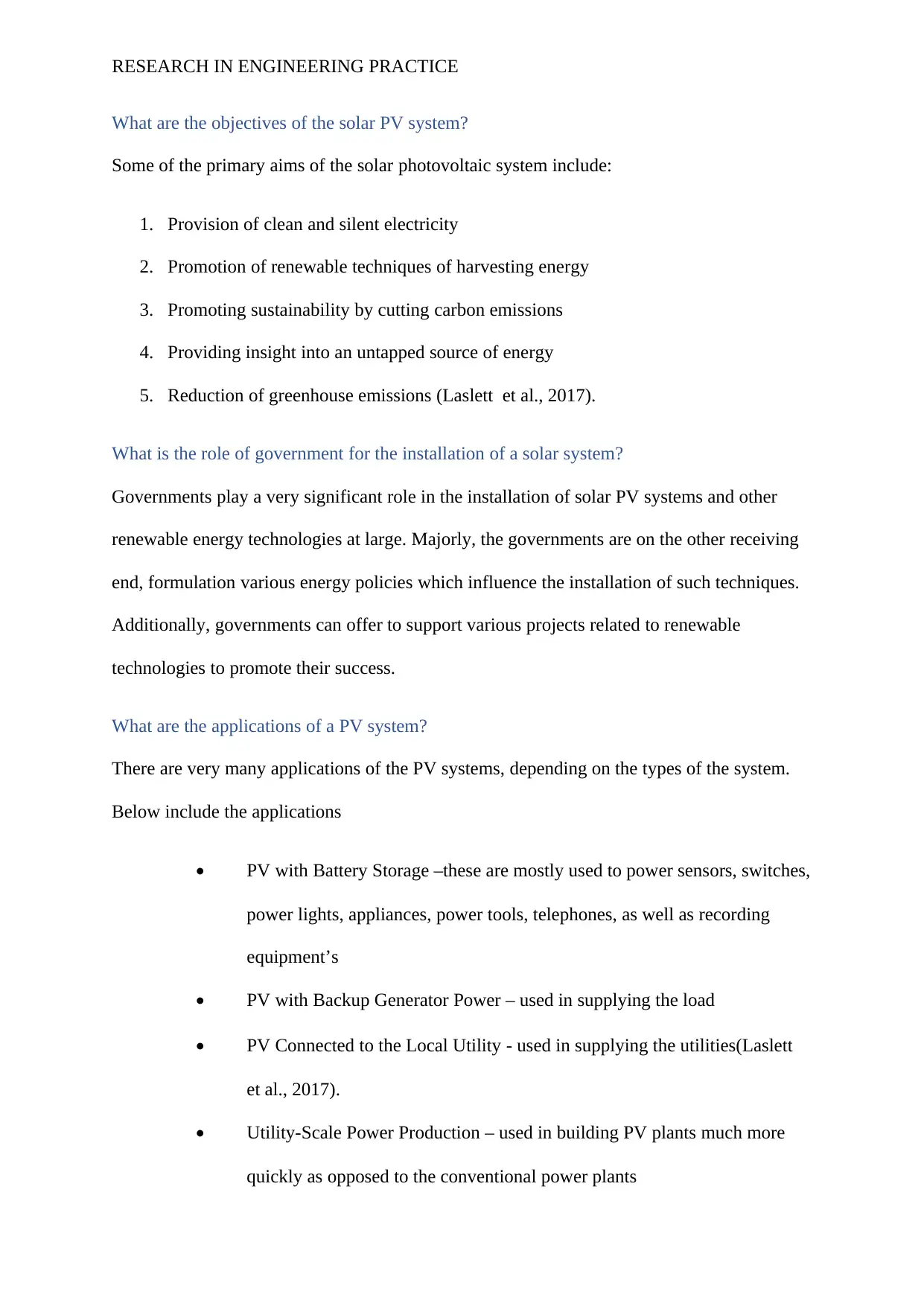
RESEARCH IN ENGINEERING PRACTICE
What are the objectives of the solar PV system?
Some of the primary aims of the solar photovoltaic system include:
1. Provision of clean and silent electricity
2. Promotion of renewable techniques of harvesting energy
3. Promoting sustainability by cutting carbon emissions
4. Providing insight into an untapped source of energy
5. Reduction of greenhouse emissions (Laslett et al., 2017).
What is the role of government for the installation of a solar system?
Governments play a very significant role in the installation of solar PV systems and other
renewable energy technologies at large. Majorly, the governments are on the other receiving
end, formulation various energy policies which influence the installation of such techniques.
Additionally, governments can offer to support various projects related to renewable
technologies to promote their success.
What are the applications of a PV system?
There are very many applications of the PV systems, depending on the types of the system.
Below include the applications
• PV with Battery Storage –these are mostly used to power sensors, switches,
power lights, appliances, power tools, telephones, as well as recording
equipment’s
• PV with Backup Generator Power – used in supplying the load
• PV Connected to the Local Utility - used in supplying the utilities(Laslett
et al., 2017).
• Utility-Scale Power Production – used in building PV plants much more
quickly as opposed to the conventional power plants
What are the objectives of the solar PV system?
Some of the primary aims of the solar photovoltaic system include:
1. Provision of clean and silent electricity
2. Promotion of renewable techniques of harvesting energy
3. Promoting sustainability by cutting carbon emissions
4. Providing insight into an untapped source of energy
5. Reduction of greenhouse emissions (Laslett et al., 2017).
What is the role of government for the installation of a solar system?
Governments play a very significant role in the installation of solar PV systems and other
renewable energy technologies at large. Majorly, the governments are on the other receiving
end, formulation various energy policies which influence the installation of such techniques.
Additionally, governments can offer to support various projects related to renewable
technologies to promote their success.
What are the applications of a PV system?
There are very many applications of the PV systems, depending on the types of the system.
Below include the applications
• PV with Battery Storage –these are mostly used to power sensors, switches,
power lights, appliances, power tools, telephones, as well as recording
equipment’s
• PV with Backup Generator Power – used in supplying the load
• PV Connected to the Local Utility - used in supplying the utilities(Laslett
et al., 2017).
• Utility-Scale Power Production – used in building PV plants much more
quickly as opposed to the conventional power plants
⊘ This is a preview!⊘
Do you want full access?
Subscribe today to unlock all pages.

Trusted by 1+ million students worldwide
1 out of 16
Related Documents
Your All-in-One AI-Powered Toolkit for Academic Success.
+13062052269
info@desklib.com
Available 24*7 on WhatsApp / Email
![[object Object]](/_next/static/media/star-bottom.7253800d.svg)
Unlock your academic potential
Copyright © 2020–2025 A2Z Services. All Rights Reserved. Developed and managed by ZUCOL.





